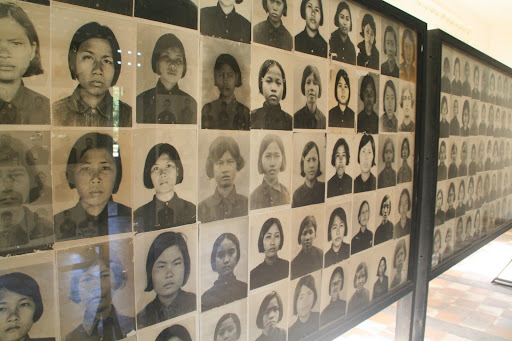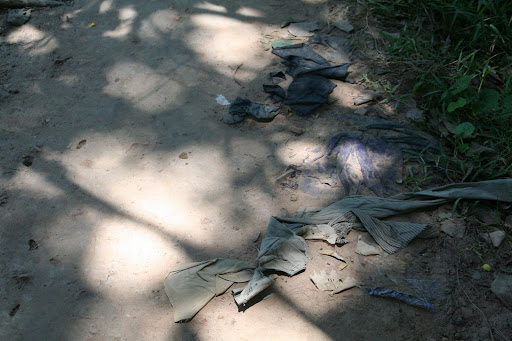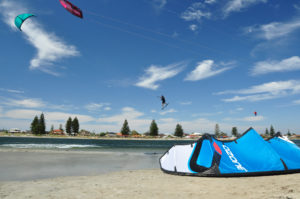Cambodia: The Genocide Years
Cambodia, Learned something new today, Reviews, RTW: 2007-2008, Southeast Asia — By Kelly on August 16, 2008 10:39 PMThe time I have spent in Cambodia combined with the knowledge I have learned about this country’s horrific history, has made me appreciate more than ever the opportunities, security, and quality of life I was granted being born in America. Cambodia has literally been to hell and back and continues to suffer today.
As I walk through the capital city of Phnom Penh, I sense the darkness from the crimes of the past that still shadow the city. As I look into the faces of all Cambodians that are my age and older, my heart saddens knowing that they must have experienced great pain in their lives and are still haunted by the terror they survived.
 My heart was first broken for the Cambodian people when I recently read “First They Killed My Father”, by Luong Ung. I knew nothing of this horrifying chapter in the history of the country, one filled with genocide and pure evil that terrorized Cambodia in the 70’s. The author is a survivor of this era, and recounts her story with the voice and viewpoint of the five year old girl she was when the Khmer Rouge regime stormed into the city, forcing her family and all others to flee the city of Phnom Penh in 1975. This book brought me to tears many times as a tried to grasp the horror of what she went through at such a young age. I thought about my very happy and blessed childhood, and felt great sadness for this little girl and all the other Cambodian children who were robbed of their childhood by Pol Pot’s regime. At a time when my friends and I had everything a kid could wish for, Luong was experiencing mass murder, starvation, and disease that eventually claimed the life of half of her family. The terror of this era is only matched by this child’s courageous spirit as she struggles for life and beats the odds. I finished the book in just a few days as I couldn’t stop reading. I also couldn’t sleep well for many nights with all the terrifying images she painted in my mind. I encourage everyone to read this deeply moving and very important book.
My heart was first broken for the Cambodian people when I recently read “First They Killed My Father”, by Luong Ung. I knew nothing of this horrifying chapter in the history of the country, one filled with genocide and pure evil that terrorized Cambodia in the 70’s. The author is a survivor of this era, and recounts her story with the voice and viewpoint of the five year old girl she was when the Khmer Rouge regime stormed into the city, forcing her family and all others to flee the city of Phnom Penh in 1975. This book brought me to tears many times as a tried to grasp the horror of what she went through at such a young age. I thought about my very happy and blessed childhood, and felt great sadness for this little girl and all the other Cambodian children who were robbed of their childhood by Pol Pot’s regime. At a time when my friends and I had everything a kid could wish for, Luong was experiencing mass murder, starvation, and disease that eventually claimed the life of half of her family. The terror of this era is only matched by this child’s courageous spirit as she struggles for life and beats the odds. I finished the book in just a few days as I couldn’t stop reading. I also couldn’t sleep well for many nights with all the terrifying images she painted in my mind. I encourage everyone to read this deeply moving and very important book.
Today, Luong Ung resides in the United States and is the national spokesperson for the Campaign for a Landmine Free World. Today there are over 2 million active landmines in Cambodia.
Click here to visit Loung Ung’s Website
We all have heard about the Holocaust in Germany, but why is it that many of us have never heard of the genocide in Cambodia that claimed the lives of 30% of the population?
A history lesson: Cambodia in the 1970’s…
During the 1960’s, Cambodia was sucked into the Vietnam conflict. After the 1970 coup, the US and South Vietnamese troops invaded the country to root out Vietnamese communist forces. They failed, and only pushed Cambodia’s communists and their Vietnamese allies deep into Cambodia’s interior. Fighting engulfed the country, ending only when Phnom Penh fell to the Khmer Rouge on April 17th, 1975, two weeks before the fall of Saigon.
From April 17, 1975 until January 7, 1979, the brutal, genocidal, ultra-Communist Khmer Rouge regime, controlled the whole of Cambodia, then known as ‘Democratic Kampuchea’. After taking Phnom Penh, the Khmer Rouge, under Pol Pot’s leadership, implemented one of the bloodiest revolutions the world has ever seen. It was considered “Year Zero” and time everyone to start over as “equals” as the regime felt the country had become corrupt from western influence and class divisions. Money was abolished, cities were abandoned, personal belongings destroyed, and everyone was forced into an agrarian society. Hundreds of thousands of Cambodians, including the vast majority of the country’s educated people, were relocated to the countryside, tortured to death, or executed. If you spoke foreign languages, or wore glasses, you were branded as a threat and killed. If one person in a family was determined to be intelligent or a threat, the entire family was killed.
During the short reign of the Khmer Rouge, about 2 million Cambodians perished, some killed outright, others dying from disease, malnutrition, neglect and mistreatment. Nicole and I saw some of the horrific remnants of the KR regime in Phnom Penh at the Choeung Ek Memorial (The Killing Fields) and the Toul Sleng Genocide Museum. It was a very long and emotionally draining day, but visiting these sites is necessary to understand Cambodia’s past and present.
*Be advised that the photos and the information told below is very disturbing*
Toul Sleng Genocide Museum (S-21)
Prior to 1975, Toul Sleng was a high school. When the Khmer Rouge came to power it was converted into the S-21 prison and interrogation facility. Inmates were systematically tortured, sometimes over a period of months, to extract confessions (usually the Khmer Rouge wanted names of their family members and others that were educated.) We saw the gallows where prisoners were hung upside down, hands tied behind their backs and interrogated until they lost consciousness. If they lost consciousness their heads were then dipped into these large pots containing filthy water containing human waste, which quickly brought the prisoners back to consciousness so they could be interrogated again. We also saw torture devises used to pull out one’s fingernails.
Barbed wire was implemented around the prison, after one prisoner jumped to his death rather than suffer more torture at the hands of the Khmer Rouge.
Detainees who died during torture were buried in mass graves inside the prison grounds. During the first part of 1977, S-21 claimed an average of 100 victims per day. If you survived the tortures of the prison, you were most likely taken by truck to the killing fields to be executed.
We walked through the corridors and into cell interrogation rooms with a single rusty bed and a disturbingly gruesome black-and-white photo of of the person who died in the room. The photo is literally of the person being found dead on the iron bed, usually surrounded by a pool of blood. These photos are a testament to the unthinkable horrors that happened there.
We walked through blood stained corridors and saw the tiny cells the prisoners were kept shackled inside. They were forced to sleep on the ground with no mat or blankets and were only allowed to bathe two times a month.
 The building now serves as a museum, a memorial and a testament to the madness of the Khmer Rouge regime. Much has been left in the state it was in when the KR abandoned it in January 1979. It is extremely disturbing, sickening, and heartbreaking. The prison kept extensive records, leaving thousands of photos of their victims, many of which are on display. I found this part of the museum to be the most heart wrenching and sickening. Each person who came to the prison was forced to pose for a mug shot, many of which show tears in their eyes. I started to feel physically ill while looking at the photos of the victims, many of which were small children. The photos of those dead depicted visible torture and malnourishment and were too much for me and I had to stop looking.
The building now serves as a museum, a memorial and a testament to the madness of the Khmer Rouge regime. Much has been left in the state it was in when the KR abandoned it in January 1979. It is extremely disturbing, sickening, and heartbreaking. The prison kept extensive records, leaving thousands of photos of their victims, many of which are on display. I found this part of the museum to be the most heart wrenching and sickening. Each person who came to the prison was forced to pose for a mug shot, many of which show tears in their eyes. I started to feel physically ill while looking at the photos of the victims, many of which were small children. The photos of those dead depicted visible torture and malnourishment and were too much for me and I had to stop looking.
 I cannot describe how horrible this place is and how bad it made me feel. The museum is not for the squeamish, but is necessary to truly understand the amount of horror that has affected Cambodia.
I cannot describe how horrible this place is and how bad it made me feel. The museum is not for the squeamish, but is necessary to truly understand the amount of horror that has affected Cambodia.
Choenung Ek Memorial (The Killing Fields)
Many of the Cambodians who perished under the Khmer Rouge regime ended up in various killing fields; that can be found scattered across the country. The killing fields were places of execution and the dumping grounds for dead bodies. The Choenung Ek Memorial is the site of the brutal executions of more than 17,000 men, women, and children, most of who first suffered through interrogation, torture and deprivation in the S021 Prison (Toul Sleng). Choeung Ek is now a group of 129 mass graves and a memorial containing 9000 human skulls found during excavations of the area in 1980. A giant stupa has been erected at this site to honor the many who lost their lives, inside of which are the thousands of skulls. Many of the skulls bear witness to the fact that they were bludgeoned to death for the sake of saving precious bullets.
Human skulls…
Victims clothing…
Nicole and I hired a guide to take us on a tour of the memorial and tell us more about the history of the era. Our guide, like most Cambodians alive today, was personally affected by the KR. He and his family had to flee the city when he was very young and two of his sisters died. He is a very sweet man and we felt so sorry for what he has been through in his life.
 The killing fields is obviously an eerie place, but it is even more so as the events that happened here are so recent that remains are still being discovered as heavy rains can unearth remnants of clothes and bones of those buried below. As we walked through the fields we would have to step over pieces of clothing that were partially buried in the ground…clothing of those murdered where we were. It was chilling. The worst was when someone spotted a tooth sticking out of the ground.
The killing fields is obviously an eerie place, but it is even more so as the events that happened here are so recent that remains are still being discovered as heavy rains can unearth remnants of clothes and bones of those buried below. As we walked through the fields we would have to step over pieces of clothing that were partially buried in the ground…clothing of those murdered where we were. It was chilling. The worst was when someone spotted a tooth sticking out of the ground.
Mass graves…
Mass grave…
The guide pointed out the tree that the KR would beat babies against to kill them. I found myself fighting back tears behind my sunglasses as our guide recounted these horrifying tales with a numbness that I could not understand. I guess life has to go on, but I am amazed by the spirits of those who survived and live to tell the tales. Perhaps more than anything, they are just happy to be alive?
In 2005 the Cambodian government privatised the Killing Fields and was paid an undisclosed sum of money by a Japanese company who manages the site and charges admission fees. This has obviously enraged many relatives of the victims who feel the government is trading their murdered loved ones for a profit.
Both of these key sites are very dark and disturbing and left me completely confused as to how mankind can be so cruel?
So how did this terror finally stop?
In late 1978, Vietnam invaded and overthrew the Khmer Rouge, who fled westward to the jungles bordering Thailand. In January of 1979, the Vietnamese installed the new People’s Republic of Kampuchea (PKR), ruling through former Khmer Rouge officials and Khmer communists. The history of the country from this point on is too much for me to wrap my head around right now. I have learned so much about the history of the Khmer Rouge era and have only begun to try to understand the politics of the country post-KR. It seems to be a history of refugees, international aid, an attempted resurgence of the Khmer Rouge, a huge civil war in 1997, followed by the now corrupt “democratic” government that is ruling the country.
If you are wondering how the Khmer Rouge was able to kill for four years without being stopped and what happened to these terrible people…below is the explanation that is displayed at the Genocide Museum.
Justice and Responsibility?
Why has it taken over thirty years to bring the former leaders of the Khmer Rouge to justice? One of the initial reasons was geopolitics. Because the Peoples Republic of Kampuchea (PRK) was supported by Vietnam, an unlikely scenario developed in which China (the main backer of the Khmer Rouge), Thailand (fearful of the Vietnam), and the United States (embroiled in the Cold War and still stung by defeat in Vietnam) and its allies conspired not just to isolate the PRK regime, but to help the Khmer Rouge, who had been routed, regrouped, and rearm (Etcheson 205; Fawthrop and Jarvis 2004) . Remarkably, in 1979 the UN General Assembly voted to give the genocidal regime Cambodia’s seat at the UN.
I find it shocking that the UN allowed the Khmer Rouge to hold a seat in the UN from 1979-1991 in essence allowing these horrible murders to represent their victims for 12 years! Man this is a crazy messed up world!?
And perhaps the worst part of it all which surely angers all Cambodians, is that the leader, Pol Pot, was never brought to trial. Disgustingly, Pol Pot died on April 15, 1998 of a heart attack. His death robbing the Cambodian people of the chance for truth and justice.
Virtually everyone in Cambodia today has been affected by the genocide years and it will take generations to recover from the destruction and terror that the Khmer Rouge brought into the lives of every Cambodian.
To see all of my photos from Phnom Penh CLICK HERE.
Tags: Cambodia, history, learned something new today, politics, southeast asia, war











1 Comment
I stumbled upon your blog last night when Googling for something totally unrelated. I am so glad your site somehow came up! I am enjoying the look at all these neat places you’ve been.
I particularly “liked” this entry. I am always trying to read about atrocities in other cultures that I have been completely unaware of before. I hate to feel so insulated and try to increase my awareness when I can. I am definitely going to read the book you mentioned.
Thank you so much for blogging about this. Another sick chapter in world history that I knew so very, very little about. 🙁